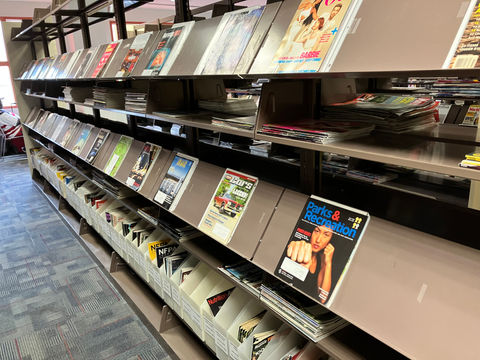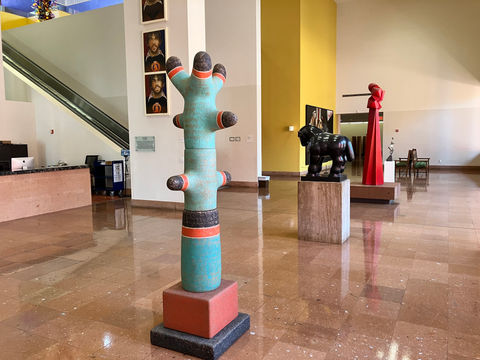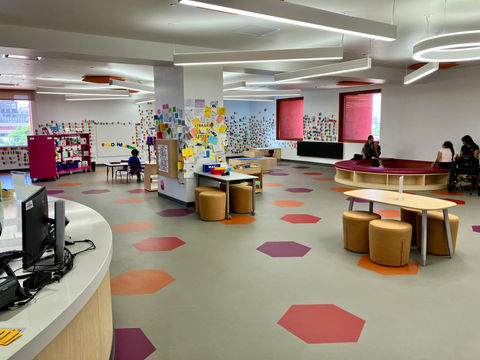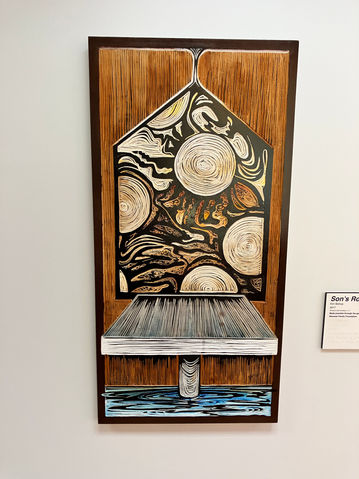LET'S CLAIM IT FOR THE NEIGHBORHOOD
The Central Library isn’t physically located in the neighborhood, but we think it’s worthy of an article in LNF Weekly in spite of that. First, it’s electronically available from anywhere, including from the neighborhood, but second, it’s so close to us and it’s such a valuable resource, that the neighborhood really ought to claim it.
Because the library offers so much, it’s impossible to write a thorough description of all its offerings, so, in this article, I’m aiming to highlight a few things that I think everyone should know about.
Let me clear out one big topic right away: I’m not going to spend any time discussing the library’s general collection of hardcopy books, neither the fiction collection nor the non-fiction collection. I think everyone understands that libraries carry books.
Instead, I want to highlight some other things that are valuable and perhaps less well-known.
For the most part, I’m going to organize this article by physical location, starting with the first floor and moving up. There are six floors and a basement in the library. The fifth and six floors aren't open to the public, and the fourth floor is adult non-fiction, which I won't be discussing here. So I'll be talking about floors one through three and the basement.
THE FIRST FLOOR
The first floor is the most diverse. It includes a big art space, service counters where you can check out and return books, the Latino Collection, Texana and Genealogy (temporary location), public use computers, new and ‘express’ books, and vinyl records. There’s also a LiftFund center — Launch SA — in the space.
Art
The library is part art gallery.

The renovated library is back in business, with a spacious and inviting first floor.
The magazine collection includes a wide variety of general and specialized publications, including books on aviation, architecture, homebuilding, politics, foreign affairs, cooking, religion, and more.
The collection is easy to use. The magazines are shelved alphabetically by title on a dozen or so shelving units. The current edition of each publication sits face-out on upper shelves, and, beneath it on a lower shelf, you’ll find an archive of past issues for that publication.
It’s simple to pick up a magazine, carry it over to one of the work tables, and read it. However, the magazines are also available for checkout.
Note that the library has a big collection of digital magazines, too, and they can be checked out, downloaded, and read in the library’s Libby application.
Cookbooks
Just past the shelves of magazines, there’s an equal number of shelves dedicated to cookbooks.
The collection is huge — there are more than three thousand cookbooks at the Central Library. They’re organized by the Dewey Decimal System, which means that they’re organized by the type of cooking they cover. Within each category, they’re sorted by author.
You can certainly walk down the aisles and browse, but I find it easier to use the online catalog. You can search on things such as type of cuisine, cookbook titles, and author names.
To give you a feel for the breadth of subject matter, I did a search on ‘vegan cooking’ and got 479 hits. A search on cookbook author Melissa Clark turned up 50 books.
It’s possible that not all of the cookbooks you find when searching will be on-hand at the Central Library, but the catalog shows you where each copy is located and whether or not it’s checked out. If you want a book that’s available only in another branch, just put a hold on it; within a few days it will be delivered to the Central Library and held for you.
Art books
There’s a huge section of the second floor that’s dedicated to art books. It’s designed for browsing and reading. Unlike most of the second floor, this area doesn’t have tall shelving units; the shelves are maybe four feet high, with books displayed on top of the units, so the space feels much more open and welcoming. There’s also plenty of casual seating in the area.
I noticed a small but interesting collection of ‘zines’. They are small, idiosyncratic magazines, inexpensively printed and with a circulation that might be in the hundreds. They cover a variety of topics, including such things as art and poetry.
THIRD FLOOR
The third floor is aimed at teens and children, with great space for each.
Children's Area
The children’s area may be the most attractive part of the library. It’s high-ceilinged and it’s bright, thanks to huge windows and child-height shelves that don’t block the outdoor light.
It’s surprising and gratifying to see families in the library, with little kids carrying armloads of books. It’s a nice counter-example to the lament that the young don’t read anymore (in my experience, that golden age when every kid loved to read never existed anyhow).

There are workspaces throughout the library, mostly one- or two-person desks. The second floor has huge tables that make it easy to spread out materials and set up a laptop that connects to the library's wifi.
You can start by checking out the building itself, from the dramatic, brightly colored and angular exterior, to the giant interior atrium with a huge glass sculpture, ‘Fiesta Tower’ by Dale Chihuly.
(Note: I’ll acknowledge that a lot of people don’t like the building; they think it’s hulking, closed-off from its surroundings, and, at the same time, too attention-seeking.)
When you come into the library from the parking garage, you’re met immediately by art. In fact, the entranceway itself is an art installation (‘Blue Room’ by Stephen Antonakos) that acts as a sort of airlock, separating the rush of the outside world from the calming environment of the library.
Then, immediately to your right, you’ll see several sculptures and, if you walk further, you’ll discover multiple works by renowned San Antonio artist Jesse Trevino. In that same area, there’s a gallery that hosts regularly changing exhibits.
In addition to all the art that's concentrated near the entrace, there's plenty more throughout the building. It's worthwhile to walk around and discover it.
Latino Collection
In the recent renovation, the library’s Latino collection moved from the sixth floor to a much more prominent location on the first floor. The new space is attractive and comfortable and includes study areas.
The Latino collection comprises about 14,000 items, most of which focus on the Mexican American experience, although other Latino cultures are represented as well.
Some of the materials in the collection are no longer in print and are available for on-site use only. However, the library sometimes has additional copies of such materials within the general collection, and those copies are available for checkout.
Texana / Genealogy Department
The library has an extensive collection of historic materials for researching San Antonio and Texas history, and for tracing genealogy.
The department’s regular space on the sixth floor is currently being renovated, but, since July 5, a reduced-space outpost has been open on the first floor. Although the department’s book collection has been put into storage while renovation proceeds, there are still cabinets full of paper records, computers for accessing databases, and microfilm machines available for use. The microfilm machines, incidentally, can scan a page — or part of a page — and transfer the image to a USB drive you bring with you, making it possible to take your research home.
The breadth of data is pretty incredible — San Antonio’s newspapers going back into the 1800s, birth and death records, Texas maps, and more.
There’s also a great staff. If you’ve got a topic you want to research, but you don’t know how to go about it, they’ll give you one-on-one help. In addition, the staff conducts classes that provide tips on how to use their resources, and you’ll find some of those classes on YouTube.
Architectural renderings of the space that’s being built out on the sixth floor look terrific, including research space, classroom space, and a conference room. But until that’s open, you can still take advantage of the department’s data and staff in its reduced-size location.
New and 'Express' Books
On the first floor, directly across from the service counter, there are shelves of new and ‘express’ books (express books can’t be renewed and can’t be put on hold). Whenever I go to the library, I make a point of scanning these books to see if anything looks interesting. Every now and then I find a gem and check it out.
Public use computers
There are public use computers throughout the library. The biggest set if them is on the first floor, which has about fifty machines available for use.
Additional machines are located in other departments, such as the Texana / Genealogy department, the teen area, and the children’s area. In addition, throughout the library there are computers set up that allow you to access and search the library’s collections.
Vinyl records
Vinyl records have made a comeback in recent years and fans say they provide a richer sound than their digital counterparts. There’s a collection of vinyl recordings on the first floor, along with a couple of players with headsets for onsite previewing.
THE SECOND FLOOR
The second floor has a big work area, and it has a lot of reference materials -- art books, newspapers, magazines, cookbooks, and the library's primary adult non-fiction area. It's also where you'll find audiobooks, graphic novels, movies, and music
Newspapers and magazines
The second floor has a terrific collection of current hard-copy newspapers and magazines. You can read the latest edition of The Express-News, The New York Times, The Wall Street Journal, or USA Today, and you can browse through hundreds of magazines.

The children's area is bright and inviting.
There are a few special features in the children’s area that are worth highlighting. One is the low-vision area that includes resources in braille and artwork that’s meant to be touched. Another is a set of read-along books. These are hard-cover children’s books that have — in addition to the usual text and drawings — attached audio players that narrate the books, including instructions for when to turn the page. These books are good for kids who are just learning to read (and, of course, for those who don’t yet read but like to have books read to them). The read-along books can be checked out, just like other library books.
Teen Area
The library has a dedicated teen space that includes books, computers, an area for creating things with materials provided by the library, and space to simply hang out.
The area is bright and welcoming, and it tends to fill up after school hours, especially with students from nearby Fox Tech High School.
The computers in the teen area, unlike the public-access machines on the first floor, don’t require signup and don’t have time limits. Among other things, they can connect students to one-on-one academic help with a live tutor, ranging from general help with writing an essay to assistance solving a single math problem. Librarians in the teen area can help students get connected with the right online tutors for their specific problem. This is a service that’s also available to students from their homes.
BASEMENT: USED BOOK STORE
The library has a used book store — the BookCellar — located in the basement of the building. Although it’s officially ‘basement’ space, it’s brightly lighted by big windows and glass doors that open onto a central courtyard.
The store is operated by The Friends of the San Antonio Library. It’s open three days each week — Thursday, Friday, and Saturday — between 11 AM and 4 PM. It’s staffed by volunteers and sells lightly used books and media at near-giveaway prices — $1 for paperbacks and $2 for hardcovers. In addition, there’s an actual giveaway section just inside the front door where you can pick up free books (there’s a reasonable limit on how many you can take).
You can reach the BookCellar via a small elevator that’s located near the Latino Collection. The big elevator bank in the middle of the library isn’t used for the BookCellar.
ELECTRONIC RESOURCES
The library has a wide variety of electronic resources that can be used by cardholders.
Library website
First, of course, is the library’s own website. Once you’ve logged in with your library card number, you can use the site to find materials, check things out, and put things on hold. Ebooks and audio books can be checked out immediately (unless all copies are in use, in which case you can hold them), and hard copy materials can be placed on hold and then picked up from the ‘hold shelf’ on the library’s first floor. It’s even possible to create a sort of ‘wish list’ (it’’s called your ‘for later’ list) of books you don’t want to check out or put on hold right now, but want to remember for the future.
The website makes searching for materials fairly easy, and it provides a handy dashboard for checking the status of your holds, checkouts, and ‘for later’ materials. It also includes tools that let you pause your holds and renew materials you’ve checked out.
The library website has lots of tools for getting recommendations. You can browse new titles, see staff recommendations, and get a selection of bestsellers and award-winners.
I often read books that I’ve seen reviewed in newspapers and magazines. Because those books are typically available to reviewers before they go on sale, it’s not uncommon for me to discover that the library doesn’t yet have the book in its collection. Sometimes I see a message that the book is on order, and I can get in line for it, but otherwise — if it’s a book I really want to read and that I think belongs in the library’s collection — I can recommend it for purchase and be notified if and when it becomes available.
Libby, an ebook and audiobook reader
There’s plenty of ebook software out there, and the library offers a good one, Libby.
Libby is a third-party tool that connects library cardholders to the magazines, ebooks, and audiobooks offered by the library. The software runs on PCs and Macs (through your browser) and as an application on both Apple and Android devices. It provides nice tools for searching your library’s electronic collection, sampling items, checking them out, placing holds, and renewing them.
Libby has an interface that I think works well for both reading ebooks and listening to audiobooks. I have multiple devices on which I read, and I like that my bookmarks synchronize across all of them.
Download Libby from Apple’s App Store or Google Play.
Databases
Your library card gives you access to a lot of online information sources that are free to cardholders. Some of them can be accessed from your home, others are available only from library computers.
You can find a listing of databases here. There are more than 170 of them.
SEATING AND WORK AREAS
There are seating and work areas throughout the library. Jane and I usually work on the second floor, which has lots of seating at long, wide tables. The tables are never crowded when we are there, so it’s easy to spread out the materials you’re working with.
The space is quiet. It absorbs and deadens sound. When you work at one of the second floor tables, just a couple of dozen feet from the information desk, you aren’t disturbed by the staff answering questions from other visitors.
The library offers free WiFi, and it seems to work pretty well. I don’t usually do any heavy downloads or streaming while I’m there, but it works very well for my standard online browsing and for some web-based apps that I use.
Incidentally, it’s ok to bring in food and drinks into the library, although there are some (simple) rules about what’s acceptable and what’s not (Snacks and dry foods are fine; Smelly and greasy foods are not. And no drinks by the computers).
EVENTS
The library hosts a lot of events, including children’s book readings, cultural performances, film clubs, book clubs, author appearances, geneaology classes, teen activities, and more.
Those events are typically listed in Jane Gennarelli’s weekly newsletter. You can sign up for the newsletter here.
PROCESSES
Getting a library card
If you live in the neighborhood, you’re eligible for a library card. You can begin the process online, but to get your card you’ll have to go in person to the library, bringing a photo ID and proof of your address (such as a driver’s license or a utility bill).
To begin your online registration, go to this page:
Once you’ve filled out the form, you need to pick up your card within ninety days. During that ninety day period, you’ll be able to check out ebooks and audiobooks, and you can reserve hard copy materials (which you then pick up when you go to the library to get your card).
Physical cards come in multiple formats — for carrying in your wallet or attaching to a keychain — and they carry your card number both printed and as a bar code.
Placing holds and checking out materials
It’s easy to check out a hard copy resource. Simply take it to a library staffer at the counter on the first floor and hand it over, along with your card. The staffer scans your card number and sets your books on a device that identifies them and marks them as checked out. You’ll get a receipt that shows the date on which the items are due.
The easiest way to find books is using the online catalog. There you can search to see if the library owns the item, and you can see if it’s currently on the shelves. If it’s checked out or available only at another branch, you can place it on hold. You’ll be notified when the book becomes available, and you’ll then find it in a ‘books on hold’ section next to the first floor computer area. Those books are organized alphabetically by the last name of the cardholder.
HOURS
As of this writing, the Central Library is open eight hours per day, except on Sunday, when it is closed. The eight-hour window varies, based on the day of the week.
On Mondays and Tuesdays, the hours run from noon until 8 PM.
Wednesday through Saturday, the hours run from 10 AM until 6 PM.
And on Sunday, the Central library is closed.
PARKING
The Central Library has a very big, multi-story, attached parking garage. The City says that there’s room in it for 400 cars. Much of the garage’s first level is reserved for library patrons, and the rest of the levels are for general public parking.
If you get your ticket validated in the library (there’s a self-operated stamp machine by the first floor entrance / exit), you’ll get three hours free. Beyond that, parking is a flat $5.00 for the day.
Entrance to the lot is on Soledad Street. For the past year or more, Soledad, where it runs past the library, has been pretty torn up. The lane that’s torn up varies from week to week, but what’s left is always a single, one-way driving lane, headed north.
Not long ago, it felt like you needed a truck or an SUV to navigate into the garage — the construction left the street a mess — but it’s much better as of this writing. You’re still driving on gravel, but it no longer feels like you’re bouncing across a big ditch.
IRONY
The Central Library is dedicated to sharing information. It has terrific resources, and it has staff that will help you find the information you need.
There’s one type of information, however, that’s really hard to uncover: Information about the library itself. Yes, the library has a website, and that website does its best to list everything that’s available.
But to write this article, I wanted to dive deeper into many of the items on that list. In fact, my original vision was a series of articles, each of which looked at a different area of the library. I wanted to talk to people with responsibility for various areas.
So, when I started work, I tried to go through the correct channels to collect more and deeper information. I submitted a media inquiry.
Based on that inquiry (and a later followup at the counter on the first floor), I did get put in touch with a library PR person, who was friendly and cordial but unable to answer any in-depth questions. We finally agreed that, as a first step, she’d put me in touch with someone responsible for the library’s collections. She told me, however, that she’d need to run it past her supervisor.
I never heard back. I followed up with an email, but got no answer.
This is not my first experience with City departments that wall off their staff and where media departments appear designed to make you give up and go away. A former Express-News reporter once laughed when I told him I tried to go through the City’s media contacts to get information.
There’s another way
Back when I was working on a series of articles regarding the City’s noise ordinance task force, I ran into the same thing. I’d reach someone in the responsible department who would promise to put me in touch with the right people, and then I’d never hear back, and my followups were useless.
I didn’t have that problem with the City of Austin. When I was doing research for my noise ordinance articles, I wanted to get some insights into how Austin’s program worked. I sent out an email inquiry and within a week I was doing a lengthy Zoom interview with the head of the appropriate department. There was someone from the City’s media team who sat in on that interview, but he didn’t say anything beyond making an introduction and then thanking me at the conclusion. To be fair, in this case I didn’t go through channels, I directly contacted the head of the department, and he then brought in the media people. But they didn’t kill it, and they didn’t get in the way.
I wish it worked that way here.
Jim Feuerstein is co-editor of LNF Weekly; he also designs and manages the website.




The second floor holds magazines, art books, non-fiction books, movies and music. It has lots of available work space.
There's art on display throughout the building, but the first floor is where it's concentrated.
The third floor has dedicated space for teens and for kids; the basement has a used book store.
You might also like...



























